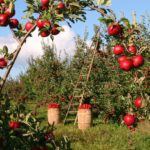Growing cherry trees from seed at home has become popular among gardeners who enjoy the challenge of caring for a tree from its very beginning. It is a rewarding experience to watch the tree grow over the years, eventually producing delicious cherries! With just a few supplies and some basic instructions, anyone can learn how to grow cherry trees from seed in their own backyard.
The first step in growing cherry trees from seed is to select the right variety. There are different types of cherry trees with different characteristics, so it’s important to choose one that will work best for your area and climate. Once you have chosen the right variety, you will need to prepare the soil and collect the seeds. Planting and caring for your cherry tree takes time and patience, but with proper guidance, anyone can learn how to do it successfully.
Finally, monitoring the health of your cherry tree is essential in order to ensure it produces healthy fruits year after year. From pruning techniques to fertilizing schedules, there are many tips and tricks that can help keep your tree healthy and strong while still bringing in a bounty of cherries each season. This article provides an overview of how to grow cherry trees from seed at home, making it easy for anyone looking to start their own orchard!
Selecting A Cherry Seed
When it comes to growing cherry trees from seed, the first step is selecting a cherry seed. Thankfully, this isn’t too difficult since you can find cherry tree seeds in most gardening stores or online outlets. However, if you want to get your hands on some fresh cherry tree seeds, you’ll need to look for them in late summer and early fall when ripe cherries are in season. The best part about this is that the seeds are free! With a little bit of effort, you can collect enough cherry tree seeds for your home garden.
When it comes to choosing which type of cherry tree seed to use, there are several things to consider. For example, some varieties of cherries are better suited for certain climates than others. Additionally, some types of cherries will produce larger and sweeter fruit than others so it’s important to choose the right kind of seed for the results you’re hoping for. Once you choose a variety that’s right for your climate and desired outcome, it’s time to prepare the seed for planting.
Fortunately, preparing the seed doesn’t require any special equipment or skills – all you need is a clean container or bowl filled with water and a little bit of patience! You’ll need to soak the cherry tree seeds overnight so they can absorb moisture and become soft enough to crack open. If everything goes according to plan, your next step will be planting the germinated seed into soil!
Preparing The Seed For Planting
Just like a chef preparing a meal, harvesting cherry tree seeds for planting requires careful preparation. Picking the right seed is the first step, but to ensure the best results, it’s important to get the seed ready for planting.
Soaking and scarifying the seed are key steps in this process. Soaking softens the shell so that it can be pierced while scarifying creates an opening in the hard outer casing to allow moisture and nutrients to reach the embryo inside. This process may take up to 48 hours of soaking, depending on how difficult it is to break through the shell.
After soaking and scarifying, it’s time to plant! Planting in shallow containers or trays with oven-dried potting soil works best. Place several seeds in each container or tray and keep them moist until they germinate and sprout. Don’t forget to label each container or tray with its contents – you don’t want any surprises when your cherry trees start to grow!
TIP: When planting, make sure that you use fresh potting soil as this helps promote healthy growth of your seeds!
Selecting A Container And Soil
It’s amazing how far the cherry tree has come—the fruit is now found in almost every grocery store. But growing a cherry tree from seed at home can be incredibly rewarding. So let’s get to it! One interesting fact to consider is that the right container and soil are essential for successful germination of a cherry tree seed.
Choosing the best container and soil doesn’t have to be intimidating. The most important thing is to select a container with good drainage, as cherry trees don’t like wet feet. A terracotta pot or wooden box with holes in the bottom works well. Additionally, avoid using regular garden soil; instead, opt for a lightweight potting mix that provides good aeration and drainage for your seedling.
Finally, when it comes to planting your cherry tree seed, you’ll want to ensure that it has enough space to expand its roots once it starts sprouting. Place your container in an area with plenty of sunlight and keep the soil moist until you observe germination — this usually takes about two weeks. Now you’re ready to put your green thumb to work!
Planting The Cherry Seed
Now that you’ve chosen the best possible container and soil for your cherry tree seed, it’s time to plant! Planting the seed is a crucial step in the growth process, so it’s important to get this right. First, fill half of your container with soil. Make sure to push down firmly on the soil when you’re done filling. Next, take your cherry seed and place it in the center of your pot or container. You can either plant it horizontally or vertically. Whichever way you choose, make sure that the seed is covered with a thin layer of soil.
Once you’ve planted your cherry seed, give it a good watering and make sure that the soil is well-saturated. This will help ensure that your cherry tree grows strong roots and has an optimal start to its life! The best thing about growing a cherry tree from seed at home is that you can monitor its progress every step of the way—from planting to providing water and light.
Not only does this provide an exciting learning experience, but it also gives you an incredible sense of accomplishment once your cherry tree is fully grown! Growing a cherry tree from seed isn’t as difficult as it may seem; now that you’ve mastered planting your cherry seed, all that’s left is to provide water and light for optimal growth.
Providing Water And Light
How much water and light do cherry tree seeds need to grow? Providing the right amount of these two elements is essential to ensure a successful germination. Let’s take a look at the five key steps for providing water and light for growing cherry trees from seed:
- Plant the seed in well-draining soil.
- Keep the soil moist but not saturated with water.
- Place the pot in an area that receives plenty of direct sunlight each day.
- Cover with a plastic dome or cling film to maintain moisture levels in the soil.
- Keep an eye on the soil moisture levels and adjust as needed, making sure it does not dry out completely or become too wet.
Creating an environment that provides just enough water and light for your cherry tree seed will encourage successful germination and growth of healthy roots and shoots. While you must ensure that you don’t over-water or expose your seedling to too much sunlight, it’s also important to pay attention to how much shade is present in its environment as well; too much shade can also hinder its growth rate. To optimize both factors, it’s best to use a combination of natural light sources and artificial lighting when needed. Additionally, keeping your seedling covered with a plastic dome or cling film helps maintain moisture levels, while allowing some air circulation which is necessary for healthy root development. By following these five steps, you can be sure that your cherry tree seedling will get all the water and light it needs to thrive!
Keeping The Seedling Covered
Ah, the age-old question: How to keep your seedling covered? We’ve all been there—the overwhelming anxiety of protecting our precious little seedlings from the elements. Well, fear not! I’m here to help you with this critical step.
Let’s take a look at keeping your seedling covered in more detail:
Methods
- Keeping the Seedling Covered Outdoors
- Mulch: Mulching is key for keeping your seedlings warm and protected from weeds and other pests.
- Frost Protection: If you live in a colder climate, consider using frost protection to protect your cherry tree seedlings.
- Keeping the Seedling Covered Indoors
- Place a Dome or Cover Over the Container: To provide warmth and protect the plant from drafts, place a dome or cover over the container.
- Grow Lights: Use grow lights to ensure that your cherry tree seedlings have enough light even during darker months.
With these methods in mind, you can rest assured that your cherry tree seedlings are safe and sound as they develop into young trees! Let’s move on now to transplanting them into their permanent home.
Transplanting The Cherry Seedling
Transplanting the cherry seedling is like taking a giant leap of faith. Just as we take risks in life to achieve our dreams, transplanting a seedling requires patience and courage. A gardener must trust that the fruit of their labour will be worth it in the end.
The cherry tree must be carefully transplanted at the right time and place for optimal growth. When digging up the seedling, ensure that you have enough space to move it into its new home without damaging any of the roots or stems. Make sure the soil surrounding the new location is loose and well-drained; this will help promote healthy root growth and development.
Once the cherry tree has been transplanted, it’s important to keep it safe from extreme weather conditions. If possible, provide shelter from strong winds or heavy rain to prevent damage to the tree’s delicate branches and leaves. It’s also essential to water your newly planted cherry tree regularly; this will help ensure that it receives adequate nutrition and stays hydrated during hot summer months. With just a bit of TLC, you can look forward to enjoying sweet cherries in no time!
Ensuring Proper Nutrition
According to the National Gardening Association, about 75% of all Americans are gardening for the first time this year. Growing a cherry tree from seed is no exception. Ensuring proper nutrition is an essential step for your cherry tree’s health and growth. Here are some helpful tips to make sure your cherry tree has the nutrients it needs:
- Fertilize your cherry tree during its growing season with a fertilizer that includes nitrogen, phosphorus, and potassium.
- Test the pH levels of the soil regularly to ensure they are in the optimal range for cherries (6.5-7).
- Provide adequate drainage by making sure there’s enough space between the roots and sides of the pot or garden bed.
- Make sure to water your cherry tree often, but avoid overwatering as this can cause root rot or other diseases.
These four steps will help ensure that your cherry tree gets the necessary nutrients to thrive and produce delicious fruit! One last factor to consider when caring for a young cherry tree is pruning away any dead wood or branches that impede its growth and development. Pruning should be done carefully and with consideration so as not to damage healthy parts of the plant – but it is necessary in order for your cherry tree to reach its full potential! Onward we go…
Pruning The Cherry Tree
Caring for a cherry tree is an incredibly rewarding experience, with the potential to bear beautiful fruit – if done right. Pruning is one of the essential steps in nurturing a cherry tree, as it helps to shape the tree and promote healthy growth.
When pruning a cherry tree, always remember that less is more. Removing too many branches can weaken or stunt the growth of the tree, while leaving too many can lead to overcrowding and disease. Aim to remove only a few branches at a time, and try to keep the overall shape of your cherry tree in mind when you do so.
It’s important to be mindful about what spots on the branch you should be cutting from as well. Make sure you are cutting just above a bud eye instead of in between two buds or at random points along the branch – this will help encourage future growth. Additionally, be sure not to leave stubs when pruning since they could potentially invite pests and diseases into your tree. With these tips in mind, you’ll be well on your way towards creating a healthy and beautiful cherry tree!
Protecting The Cherry Tree From Pests And Disease
Keeping your cherry tree healthy is essential for a successful harvest. To protect it from pests and diseases, you need to know what to look for. First of all, watch out for two-spotted spider mites, which can cause leaf yellowing and drop. They thrive in hot, dry conditions so keep the area around the tree moist with regular watering and mulching. You can also use insecticidal soap or horticultural oil to control them.
Next, keep an eye out for aphids, which suck sap from the leaves and stems of your cherry tree. If left unchecked, they can weaken the tree and cause dieback. Natural predators like ladybugs can help control them but if you need additional support you may want to consider using a spray insecticide.
Finally, disease prevention is key to protecting your cherry tree. Start by choosing disease-resistant varieties and planting in well-draining soil with plenty of organic matter to promote good drainage and aeration. Be sure to prune away any dead or diseased branches as soon as they are noticed and prevent overcrowding by thinning out branches if necessary. Additionally, make sure you water at ground level rather than overhead to reduce the risk of fungal diseases spreading through splashing water droplets on the leaves.
TIP: Regularly inspect your cherry tree for signs of pests or disease throughout the growing season so that any issues can be addressed quickly before they have time to become a big problem!
Harvesting The Cherries
Ah, the sweet rewards of growing one’s own cherry tree – the pride, the satisfaction… and of course, the delicious cherries. Yet many gardeners forget that harvesting these fruit requires a whole lot more than just picking them off the tree. Here are 5 essential tips to properly harvest your home-grown cherries:
Monitor their ripeness: Cherries should be slightly soft when ready for harvest but still firm enough to remain on the branch.
Use a ladder: The higher branches can be difficult to reach without some extra help. Invest in a sturdy ladder that can support your weight. Don’t forget to wear gloves too!
Handle with care: When picking cherries, gently twist them from their stems and place them into shallow containers or buckets that won’t bruise the fruit as it is harvested.
Pick in early morning: Not only will this reduce stress on heat-sensitive fruits, but also make sure you pick from ripe fruits before pests and birds get to them first!
Don’t overfill your container: The weight of too many cherries will make it difficult to carry without squishing some of the fruit.
Harvesting your cherries is not only an exciting time, but also an important step in ensuring that you have enough fresh fruit on hand for all of your recipes! Now comes the next task – handling those freshly harvested cherries so they stay good until you’re ready to use them.
Handling The Freshly Harvested Cherries
Harvesting the cherries is a rewarding experience, but it’s only half of the job. After you’ve gathered your haul, you’ll need to handle the freshly harvested cherries with care. From washing them off to storing them properly, these steps can help ensure that your cherries are in perfect condition when it’s time to eat them.
First and foremost, all of the leaves and stems should be removed from each cherry before storing it. This will help keep any pests or diseases from spreading and ruining your entire batch. Additionally, any damaged or bruised fruit should be discarded as soon as possible to prevent contamination of the rest of your crop.
After sorting through the fresh-picked cherries, you’ll want to give them a quick rinse before storing them away. This will remove any dirt or debris that may have been picked up during harvesting. It’s important to use cool water for this step and then let the fruit air dry on a clean towel before packing it away for storage.
Once everything is cleaned off, you’re ready to store your precious bounty! Place the cherries in an airtight container or plastic bag and store in the refrigerator or freezer until you’re ready to enjoy their sweet taste. Now that your hard work has paid off, there’s nothing left to do but savor every juicy bite!
Storing The Cherries
Storing cherries is like a dance between time and temperature. You need to ensure that you are making the most of the short window of opportunity to get the most out of your harvest. Here’s how you can make it work for you:
• Place your cherries in shallow containers, allowing for air circulation; • Keep them away from direct sunlight and refrigerate or freeze as soon as possible; • Choose a cool, dark place with good ventilation if you cannot refrigerate or freeze them right away; • Monitor their quality regularly and discard any that show signs of spoilage.
By implementing these strategies, you are taking advantage of every minute until they’re ready to be used. But there is still more to be done – establishing a maintenance schedule to keep the trees healthy. Transitioning from storing your freshly harvested cherries to this next step will help ensure a successful harvest for years to come.
Establishing A Maintenance Schedule
An ounce of prevention is worth a pound of cure.” Establishing a maintenance schedule for your cherry tree is an essential part of the process in growing it from seed. Maintenance involves everything from watering and pruning to monitoring for pests and diseases, so it’s important to stay on top of this.
Start by creating a basic plan that outlines how often you’ll water the tree, when you’ll fertilize it, and what type of pruning will be done. Don’t forget to make note of any changes in the climate over time that could affect your tree’s health. A good rule of thumb is to check on your tree every two weeks or so, depending on the season.
It’s also important to do regular checks for disease or pest infestations. Look closely at the leaves for signs of damage or discoloration and inspect the trunk and branches for any structural issues such as cracks or splits. If you find any signs of disease or pest infestation, take action immediately by consulting with a professional arborist or horticulturist.
With proper maintenance and care, your cherry tree can thrive and bear fruit in no time! With that in mind, let’s move onto troubleshooting some common problems that may arise while growing your cherry tree from seed.
Troubleshooting Common Problems
When it comes to growing a cherry tree, hitting a few bumps in the road is to be expected. After all, ‘nothing worth having comes easy.’ That’s why we’ll cover common problems and how to troubleshoot them.
The first issue you may come across is that of a pest infestation. Fortunately, there are many natural methods for dealing with this such as introducing beneficial predatory insects or spraying with neem oil. Additionally, keeping weeds away from your cherry tree can also help reduce pests.
Finally, if your cherry tree doesn’t seem to be bearing fruit despite taking all the necessary steps for growth, it could be due to a lack of pollination. Consider investing in bees or hand pollinating with an artist’s brush if this turns out to be the case. It’s important to take action quickly because a lack of pollination can lead to poor fruit production and even stunt growth.”
Frequently Asked Questions
How Long Does It Take To Grow A Cherry Tree From Seed?
Growing a cherry tree from seed is like nurturing a young child. It takes patience, perseverance, and plenty of love to ensure its growth into maturity. Just as we do with a child, providing the right environment, conditions and resources for the seed will be essential for it to thrive.
But how long does it take for this sapling to reach full bloom? As with any living thing, there is no one-size-fits-all answer. It depends on the species of cherry tree you are growing, the climate in which it is planted and the care you give it. Generally speaking, however, most cherry trees will reach their full size within 6-8 years after germination.
In order to ensure that your cherry tree grows in accordance with these estimates, you’ll need to properly prepare your soil prior to planting the seeds and provide nutrients such as compost or fertilizer throughout its development. Additionally, regular watering and pruning will help your sapling thrive as well as protect it from disease or pests.
With proper care and attention given to the needs of your seedling, you can expect to have a beautiful cherry tree in full bloom just in time for spring!
How Often Do Cherry Trees Need To Be Watered?
Growing cherry trees from seed is an exciting prospect that can take your garden to the next level! But, if you want your seedlings to turn into healthy and fruitful trees, you need to pay attention to the watering needs of the saplings. How often do cherry trees need to be watered? Well, it’s almost impossible to overstate just how important regular watering is for cherry tree seedlings!
Watering a newly planted cherry tree should be done at least once or twice per week. Depending on the weather in your area, you may even need to water more frequently. Keeping the soil moist but not soggy is key. If you water too little, the seedling will become stressed and will struggle to thrive, while if you water too much, root rot could set in and damage your tree.
It’s essential that you get this balance right when taking care of young cherry trees; they are very sensitive plants that need tender loving care if they are going to reach their full potential. If possible, try using drip irrigation or soaker hoses rather than overhead sprinklers as these help keep water off the leaves and trunk of the tree. This reduces the chances of fungal diseases and other issues caused by excessive wetness.
Knowing how often to water your cherry tree seedlings is critical for having successful plants that can produce delicious fruit year after year! Make sure that you pay close attention to moisture levels in both the soil and air when caring for your new plantings; with proper hydration, there’s no limit to what these beauties can achieve!
Is It Necessary To Prune A Cherry Tree?
Oh, the never-ending saga of pruning cherry trees! It seems like it’s always a hot topic amongst gardeners, and yet we still don’t have any definitive answer. Is it necessary to prune a cherry tree? Well, let’s take a closer look.
We all know that pruning is important for keeping our trees healthy and helping them reach their full potential. But when it comes to cherry trees specifically, there’s no one-size-fits-all rule. Some gardeners swear by regular pruning; others are convinced that their cherry trees will be just fine without it. So what’s the verdict?
The truth is, whether or not you need to prune your cherry tree depends on several factors: its type, location, soil quality and climate. If you’re growing a dwarf variety in a warm climate with rich soil, then regular pruning is probably unnecessary. On the other hand, if you’re nurturing a larger variety in an area with poor soil quality and cooler temperatures, then more frequent trimming may be beneficial for keeping your tree healthy and strong.
It can be difficult to determine exactly how much – or how little – maintenance your particular cherry tree needs. So if you’re ever unsure about what to do, why not consult an expert? After all, getting some professional advice can help ensure that your beloved tree gets the care it deserves – now and in the future!
How Can I Tell When The Cherries Are Ripe For Harvesting?
Knowing when the cherries are ripe for harvesting is an essential part of growing cherry trees. It’s like a game of hide and seek, where the tree is hiding its ripening fruit from you. But with a little bit of patience and practice, you can be successful at finding those sweet fruits.
One way to tell if the cherries are ready to pick is by gently squeezing them. If they feel soft and tender, then it’s time to start picking! You should also pay attention to their color; when they turn from green to red or yellow, that means they’re getting close to ripeness. Additionally, take a whiff – if you smell something sweet coming from the cherry tree, that means its time to harvest!
Finally, don’t forget about timing! Different varieties of cherry trees ripen at different times throughout the season, so research your specific type ahead of time so you know when to expect your harvest. It’s also important to keep in mind that some varieties can produce two harvests per season; make sure you check regularly so you don’t miss out on any ripe cherries!
TIP: If possible, visit your local farmer’s market or orchard in order to get an idea of what ripe cherries look like before attempting harvesting your own. This will help ensure that you know exactly what signs to look for once your tree starts producing fruit!
Is There A Specific Type Of Soil Needed For Growing Cherry Trees From Seed?
Irony holds that the easiest things in life are often the most difficult. Planting a cherry tree from seed is one of those activities! It’s definitely a challenging endeavor – one that requires careful attention and specific soil requirements. So, if you’re wondering, “Is there a specific type of soil needed for growing cherry trees from seed?” The answer is an emphatic yes!
The quality of the soil has a direct impact on how well the tree will grow. Good soil should have plenty of organic material, such as compost or manure, mixed into it to provide essential nutrients. Additionally, the soil should be slightly acidic; this is especially important for sour cherry varieties. Finally, make sure your chosen location has good drainage and isn’t prone to standing water as this can cause root rot and other diseases.
In summary, when planting cherry trees from seed at home, it’s important to select an appropriate soil type for maximum growth and health of the tree. By adding organic matter, maintaining pH balance and ensuring adequate drainage in the area you choose to plant your tree, you’ll set yourself up for success in growing a thriving cherry tree!
Conclusion
Growing a cherry tree from seed is not an easy task, but with the right knowledge and dedication, it can be done. It’s important to understand that this process takes time, patience and effort. The seeds need to be planted in the proper type of soil and watered regularly. Pruning needs to be done on a regular basis as well, in order to ensure that the tree will produce healthy cherries when they are ripe. Knowing when the cherries are ripe for harvesting is also key – you’ll need to monitor the color of the fruit and make sure there’s no damage or discoloration before picking them off the tree.
The theory that growing cherry trees from seed takes time, dedication and effort is true in all regards – while it may seem daunting at first glance, taking all of these steps will result in a healthy cherry tree that produces delicious fruit year after year. With a bit of care and attention, you can have your own cherry tree in your garden before you know it!
At the end of the day, growing a cherry tree from seed isn’t something that just anyone can do – it takes knowledge and skill to get it right. But if you take your time, follow the proper steps and keep an eye on your progress along the way, you’ll eventually reap the rewards of your hard work: years’ worth of delicious cherries ready for harvesting!





























